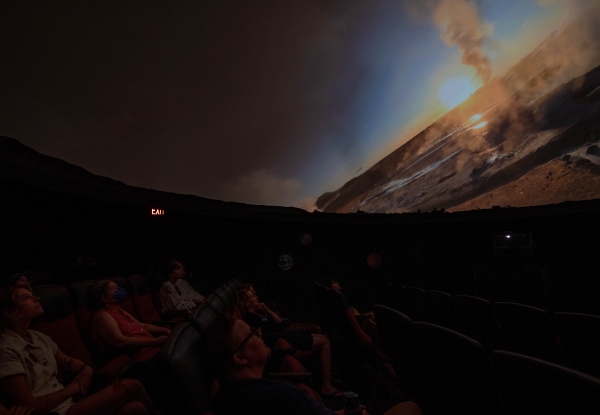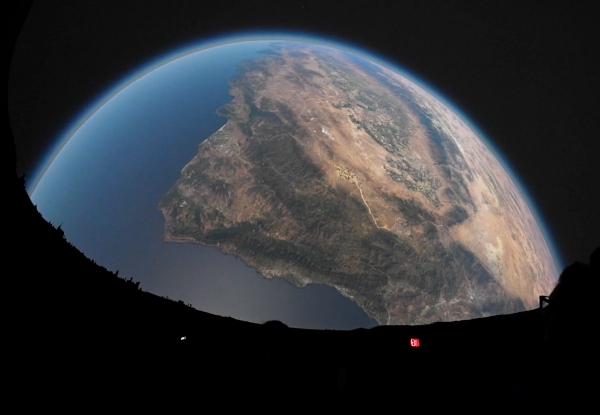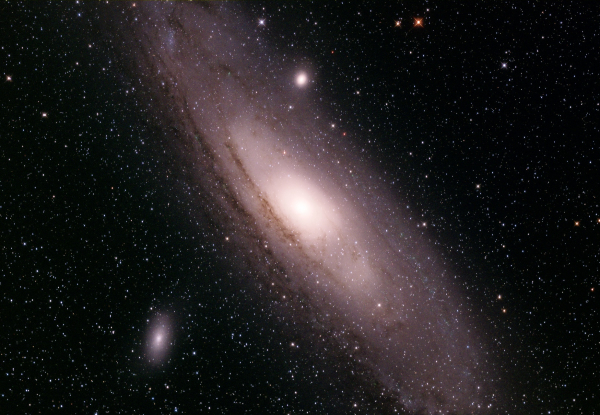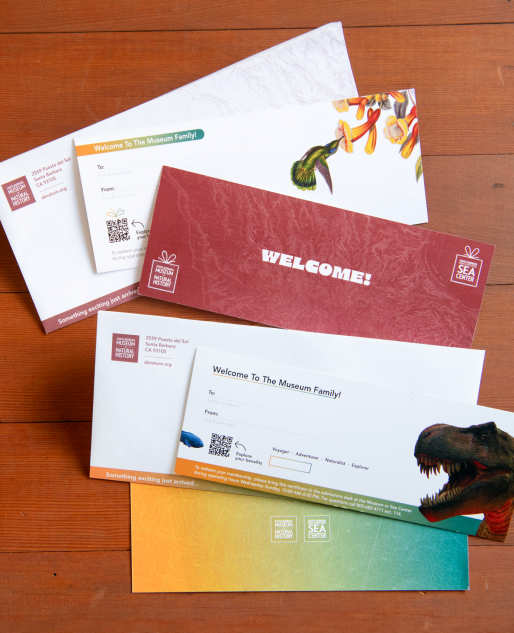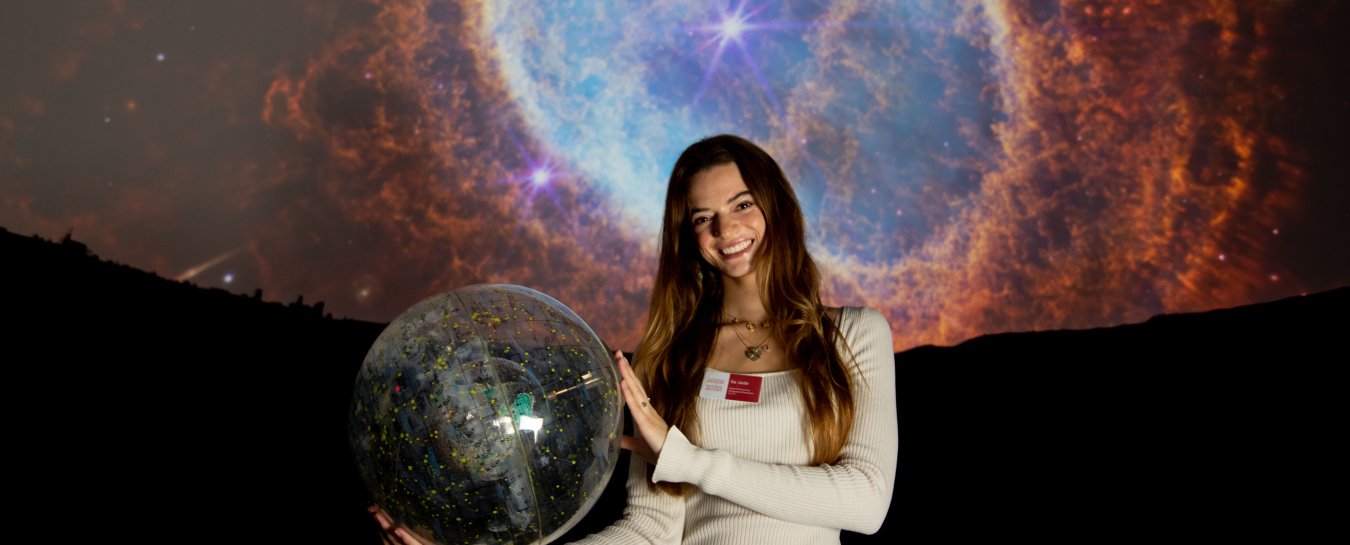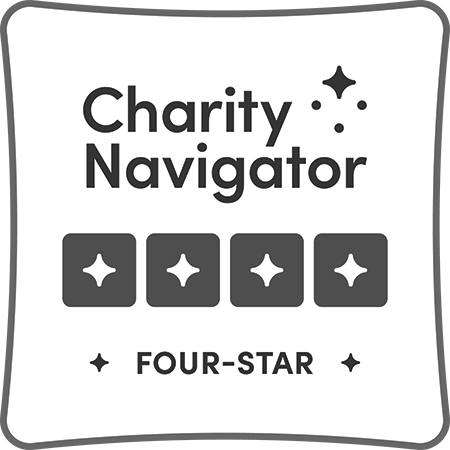Gladwin Planetarium
Inside our theater, the stars are always out. Our expert Astronomy Programs presenters are ready to answer your questions during interactive live presentations. Get to know the stars of Santa Barbara, the universe, and the wonders of space. Our Evans & Sutherland Digistar 7 dual-projection system with 4K resolution allows us to provide exciting, immersive educational adventures. Members enjoy quarterly shows on special topics after hours. The planetarium is not ADA accessible; visit our accessibility page for more information.
Planetarium tickets are free with admission (and admission is free for Members). Tickets are available at the planetarium 20 minutes before the showtime. We recommend coming early to ensure a ticket, and seating is first come, first served. No late entry is granted. Want to spend more time exploring space in the planetarium? Sign up for our upcoming course on James Webb Space Telescope discoveries!
Visiting December 22–24? Check out our Christmas schedule.
Visiting December 26–January 6? Check out our winter break schedule.
Visiting January 7–March 21? Check out our winter schedule.
Fall Schedule: Sept. 2–Dec. 21
Weekdays
-
1:30 PM – Fall Skies Over Santa Barbara
(recommended for ages 5 and up; 30 minutes)Join us for a tour of tonight’s sky. We’ll learn about the constellations and planets visible in Santa Barbara in fall, along with any upcoming astronomy events like meteor showers, comets or eclipses. This live presentation includes a Q&A with the presenter.
Weekends
-
11:00 AM – The Night Sky for Little Dippers
(recommended for all ages; 15 minutes)This 15-minute presentation is targeted at young audiences with different topics at every show. Come back again and again with your little one to build up their enthusiasm and excitement for space!
-
12:00 PM – Space Oddities
(recommended for ages 5 and up; 30 minutes)Take a tour of the weird and wonderful in space! From our cosmic backyard to the farthest reaches of our galaxy, we’ll see all the space oddities our universe has in store. This live presentation includes a Q&A with the presenter.
-
2:00 PM – Mensajeros del Tiempo y el Espacio
Película en español con subtítulos en inglés
Spanish-language movie with English subtitles
(se recomienda para edades de 5 años y arriba; 30 minutos)
Explora la forma como el Observatorio Internacional Gemini y el Observatorio Rubin revolucionarán nuestra comprensión del cosmos. Este espectáculo muestra la forma en la que Gemini trabajará colaborando con otros observatorios que vigilan el cielo nocturno en buscando explicar los acontecimientos astronómicos que cambian con el tiempo. -
3:00 PM – Fall Skies Over Santa Barbara
(recommended for ages 5 and up; 30 minutes)Join us for a tour of tonight’s sky. We’ll learn about the constellations and planets visible in Santa Barbara in fall, along with any upcoming astronomy events like meteor showers, comets or eclipses. This live presentation includes a Q&A with the presenter.
Christmas Schedule: Dec. 22–24
-
11:00 AM – Santa's Starry Ride
(recommended for all ages; 30 minutes)Join Santa’s holiday journey around the world! Together we will explore the night sky and holiday spirit.
-
12:00 PM – Santa's Starry Ride
(recommended for all ages; 30 minutes)Join Santa’s holiday journey around the world! Together we will explore the night sky and holiday spirit.
-
2:00 PM – Mensajeros del Tiempo y el Espacio (no habrá espectáculo el 24 de diciembre)
Película en español con subtítulos en inglés
Spanish-language movie with English subtitles (se recomienda para edades de 5 años y arriba; 30 minutos)
Explora la forma como el Observatorio Internacional Gemini y el Observatorio Rubin revolucionarán nuestra comprensión del cosmos. Este espectáculo muestra la forma en la que Gemini trabajará colaborando con otros observatorios que vigilan el cielo nocturno en buscando explicar los acontecimientos astronómicos que cambian con el tiempo. -
3:00 PM – From Earth to the Universe (no show on Dec. 24, when Museum closes at 3:00 PM)
(recommended for ages 5 and up; 30 minutes)The night sky has been the subject of campfire stories, ancient myths, and awe for as long as there have been people, but only recently have we truly begun to grasp our place in the cosmos. Explore this journey of celestial discovery, from the theories of ancient Greek astronomy to today’s grandest telescopes.
Winter Break Schedule: Dec. 26–Jan. 6
-
11:00 AM – The Night Sky for Little Dippers
(recommended for all ages; 15 minutes)This 15-minute presentation is targeted at young audiences with different topics at every show. Come back again and again with your little one to build up their enthusiasm and excitement for space!
-
12:00 PM – Notable Nebulae
(recommended for ages 5 and up; 20 minutes)Experience an up-close view of breathtaking colorful displays in space during this live presentation. We will explore what nebulae are, how they came to be, and what they mean for us here on Earth.
-
2:00 PM – Mensajeros del Tiempo y el Espacio
Película en español con subtítulos en inglés
Spanish-language movie with English subtitles (se recomienda para edades de 5 años y arriba; 30 minutos)
Explora la forma como el Observatorio Internacional Gemini y el Observatorio Rubin revolucionarán nuestra comprensión del cosmos. Este espectáculo muestra la forma en la que Gemini trabajará colaborando con otros observatorios que vigilan el cielo nocturno en buscando explicar los acontecimientos astronómicos que cambian con el tiempo. -
3:00 PM – From Earth to the Universe (recommended for ages 5 and up; 30 minutes)
The night sky has been the subject of campfire stories, ancient myths, and awe for as long as there have been people, but only recently have we truly begun to grasp our place in the cosmos. Explore this journey of celestial discovery, from the theories of ancient Greek astronomy to today’s grandest telescopes.
Winter Schedule: Jan. 7–Mar. 21
Weekdays
-
1:30 PM – Winter Wonders Over Santa Barbara
(recommended for ages 5 and up; 30 minutes)Join us for a tour of tonight’s sky. We’ll learn about the constellations and planets visible in Santa Barbara in winter, along with any upcoming astronomy events like meteor showers, comets, or eclipses. This live presentation includes a Q&A with the presenter.
Weekends
-
11:00 AM – The Night Sky for Little Dippers
(recommended for all ages; 15 minutes)This 15-minute presentation is targeted at young audiences with different topics at every show. Come back again and again with your little one to build up their enthusiasm and excitement for space!
-
12:00 PM – Notable Nebulae
(recommended for ages 5 and up; 20 minutes)Experience an up-close view of colorful, breathtakingdisplays in space during this live presentation. We will explore what nebulae are, how they came to be, and what they mean for us here on Earth.
-
2:00 PM – Mensajeros del Tiempo y el Espacio
Película en español con subtítulos en inglés
Spanish-language movie with English subtitles (se recomienda para edades de 5 años y arriba; 30 minutos)
Explora la forma como el Observatorio Internacional Gemini y el Observatorio Rubin revolucionarán nuestra comprensión del cosmos. Este espectáculo muestra la forma en la que Gemini trabajará colaborando con otros observatorios que vigilan el cielo nocturno en buscando explicar los acontecimientos astronómicos que cambian con el tiempo. -
3:00 PM – Winter Wonders Over Santa Barbara
(recommended for ages 5 and up; 30 minutes)Join us for a tour of tonight’s sky. We’ll learn about the constellations and planets visible in Santa Barbara in winter, along with any upcoming astronomy events like meteor showers, comets, or eclipses. This live presentation includes a Q&A with the presenter.

